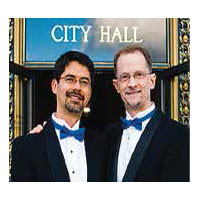 By Stuart Gaffney and John Lewis
By Stuart Gaffney and John Lewis
We title our column “6/26 and Beyond” because, for the last fourteen years, June 26 has been the day the U.S. Supreme Court issued its key pro-LGBT equality decisions. 2017 was no exception. On June 26, 2017, the U.S. Supreme Court in the case of Pavan vs. Smith made even more explicit what it had already made clear before: When it comes to marriage, government must treat same-sex couples the same as different-sex couples.
In some ways akin to a number of states’ resistance to integrating public schools in the wake of Brown v. Board of Education, a handful of states have tried to evade the clear dictates of the U.S. Supreme Court’s two landmark marriage equality decisions—Obergefell, recognizing the freedom to marry nationwide, and Windsor, striking down federal government discrimination against married same-sex couples.
One such state is Arkansas, where the state Department of Health in 2015 refused to put both same-sex spouses’ names on birth certificates for children conceived through artificial insemination as the department does for different-sex couples. Last year, a divided Arkansas Supreme Court upheld this discrimination. Last month, however, the U.S. Supreme Court said “no way”—in Pavan, a per curiam decision, issued without even the need for full briefing or oral argument. Per curiam decisions are “reserved for cases where ‘the law is settled and stable, the facts are not in dispute, and the decision below is clearly in error,’” and the Court found that Pavan was one of those cases.
In the opening line of the opinion, the Supreme Court repeated loud and clear its holding in Obergefell: “the Constitution entitles same-sex couples to civil marriage ‘on the same terms and conditions as opposite-sex couples.’” The Court went on to explain that Arkansas’ “differential treatment [of same-sex couples] infringes Obergefell’s commitment to provide same-sex couples ‘the constellation of benefits that the States have linked to marriage.’”
The Court further stated: “Obergefell proscribes such disparate treatment. As we explained there, a State may not ‘exclude same-sex couples from civil marriage on the same terms and conditions as opposite-sex couples.’” And the Court pointed out that birth certificates were one of the specific examples the Obergefell court gave of “the ‘rights, benefits, and responsibilities to which same-sex couples, no less than opposite-sex couples, must have access.”
 Sadly, newly appointed Justice Neil Gorsuch, joined by Justices Thomas and Alito, filed a groundless and unprincipled dissenting opinion. In a 2016 speech turned law review article submitted to the Senate for his confirmation hearings, Gorsuch addressed the importance of precedent in the American legal system. He said: “[E]ven when a hard case does arise, once it’s decided it takes on the force of precedent, becomes an easy case in the future, and contributes further to the determinacy of our law. Truly the system is a wonder and it is little wonder so many throughout the world seek to emulate it.”
Sadly, newly appointed Justice Neil Gorsuch, joined by Justices Thomas and Alito, filed a groundless and unprincipled dissenting opinion. In a 2016 speech turned law review article submitted to the Senate for his confirmation hearings, Gorsuch addressed the importance of precedent in the American legal system. He said: “[E]ven when a hard case does arise, once it’s decided it takes on the force of precedent, becomes an easy case in the future, and contributes further to the determinacy of our law. Truly the system is a wonder and it is little wonder so many throughout the world seek to emulate it.”
What truly is a wonder is how Gorsuch could not see that Obergefell is undeniably precedent and Pavan was an easy case. Significantly, Chief Justice Roberts, who strongly dissented in the Obergefell decision, did not join Gorsuch’s dissent. Per curiam decisions have no named author, and individual justices are not required to indicate their votes on such decisions. Roberts’ decision not to dissent by name, however, may mean he respects Obergefell as precedent, even though he disagrees with it.
Pavan should send an unmistakable message to other states and lower courts who might attempt to sidestep the clear constitutional protections of liberty and equality that Obergefell and Windsor afford LGBT couples. Just four days after Pavan was decided, however, the Texas Supreme Court issued a unanimous decision, allowing a lawsuit to proceed that challenges whether local governments must provide health insurance and other spousal benefits to married same-sex couples when it does so to different-sex couples. And even after Pavan, Indiana continues to defend in court its differential treatment of same-sex couples with respect to birth certificates.
The U.S. Supreme Court’s enforcement of the Constitution’s guarantees of liberty and equality for LGBT people remains critical to our lives. The composition of the Supreme Court is vital to future success. We still need more 6/26 victories in the future. With rumors abounding as to whether Justice Kennedy, the author of all of the Court’s landmark gay rights decisions, may retire as early as next year, many who support LGBT equality, women’s rights, and myriad other concerns are anxious.
Doing everything we can to flip the U.S. Senate in 2018 to a chamber that will only confirm a Justice who respects the constitutional and other legal rights of LGBT people is a strategic priority. Everything we as LGBT people have done for decades to win the hearts and minds of millions of Americans helps us inside the courtroom. Now, more than ever, is the time to engage.
John Lewis and Stuart Gaffney, together for over three decades, were plaintiffs in the California case for equal marriage rights decided by the California Supreme Court in 2008. Their leadership in the nationwide grassroots organization Marriage Equality USA contributed in 2015 to making same-sex marriage legal nationwide.
Recent Comments